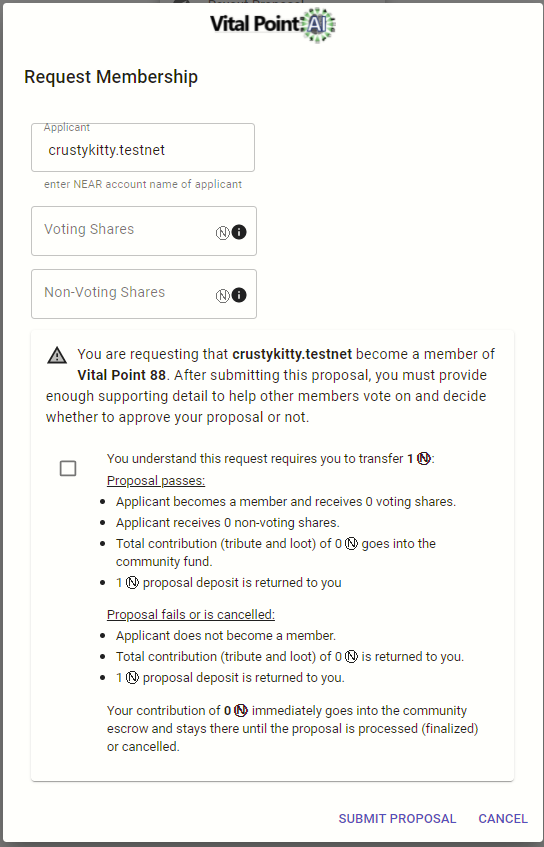Member Proposals
One of the first proposal types you will come across, either as a community owner or someone looking to join other communities on Catalyst is the member proposal.
Member proposals are exactly what they sound like - a request to become a member of a community.

Being a member of a community means you may have responsibilities to fulfill as a community member, such as considering, discussing, and voting on proposals.
There are two types of members: voting members and non-voting members. When submitting a member proposal, you'll want to consider which is most appropriate for you.
Let's go over the various parts of the membership proposal form:
Applicant
Usually the applicant is the person who is requesting membership; however, anyone is able to submit a member proposal at a community for someone anyone else.
You'll enter the near account name (e.g. aaron.near) of the person requesting membership.
Voting Shares
Members can give a contribution (aka Tribute) to the community fund to buy voting power - which makes communities on Catalyst plutocratic by default. Plutocracies have inherent issues, so we've mitigated some of the risk of that by implementing a system of proxy voting or delegation on the platform. Anyone can delegate their shares to anyone else - which is useful for variety of reasons. You can read more about vote delegation and what we're working on for voting policies later in the docs.
When requesting membership, if you want voting rights, you will need to contribute to the community fund. Every 1 NEAR you contribute gives you 1 voting share.
Note: Giving to the community fund does not mean you immediately lose control of the NEAR you contributed. You become a part owner of the community fund and will always be entitled to leave with your share of the fund (based on how many shares you have) at any time.
Non-Voting Shares
Non-voting shares (aka Loot) are for people who want to be part of the community and who want to share in ownership of the community fund, but know from the start that they have no intention of participating in the governance of that fund.
Likewise, it's a method to invite members to join the community who may provide subject matter advice, but ultimately will not have any say (beyond influence) in how the community resources are used.
Again, entering an amount in non-voting shares will give you 1 non-voting share for every 1 NEAR you contribute to the community fund.
Confirmation Area
As you start entering accounts and amounts in the form, the bottom confirmation area of the form will change to give you a complete summary of exactly what it is you are about to do.
Perhaps most importantly it tells you what happens after you submit the proposal. Once submitted, you will need to add sufficient detail to it to introduce the member and explain why they should be a member of the community. This typically takes the form of a brief introduction and potentially links to more information about them held elsewhere.
If the member already has a Persona on Catalyst, that information will automatically be available.
Once sufficient information is available, a member of the community will need to sponsor the proposal which sends it for a community vote which will pass or fail depending on the specific community voting threshold setting.
Note: all proposal actions on Catalyst require a proposal deposit. This helps prevent spammers from submitting multiple useless proposals. Communities can set their own proposal deposit requirements and how they are used, but in their default form, deposits are returned to whomever made them once proposals pass, fail, or are cancelled. The confirmation area will make it clear what happens to the NEAR you are transferring as part of the proposal process.
Previous
Next
Enter your text here...